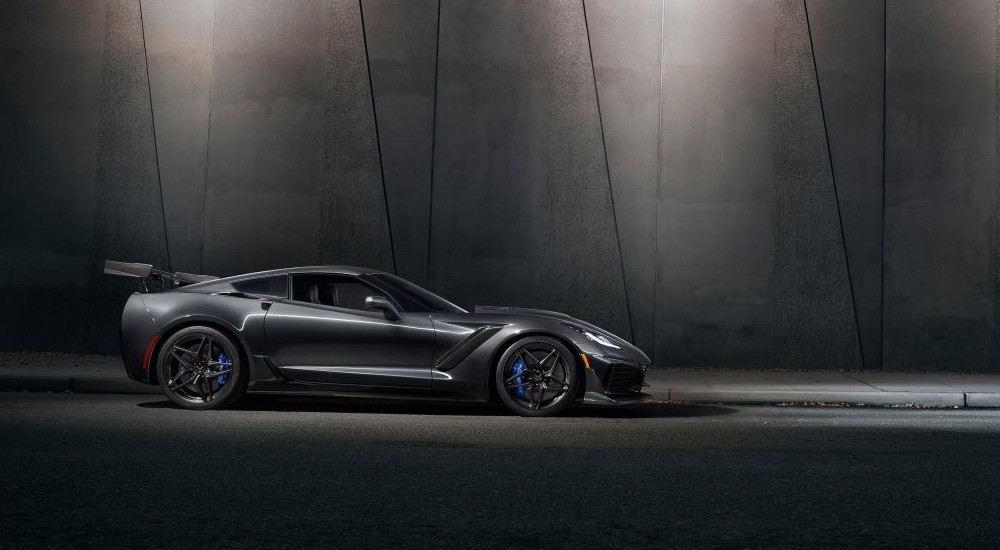
There are plenty of options for drivers in the market for a high-performance ride that will inject a little excitement into their daily drive. From pure sports cars and muscle cars to pony cars, supercars, and hypercars, it can get to the point where the differences between different categories can start to become as blurry as the cars themselves. To the uninitiated, any fast, low-slung coupe probably reads as a sports car, but when you start to drill down into the differences between various classifications, that impression quickly evaporates.
These segments vary widely in terms of price and performance, from relatively affordable pony cars like the Chevy Camaro 1 LS and Ford Mustang EcoBoost, which both ring in at less than $30,000, to one-of-a-kind feats of hypercar engineering like the Bugatti Chiron Super Sport 300+ which will set you back some $3.9 million.[a] Granted, most drivers aren’t going to have that sort of cash to part with when shopping for their next ride, so instead of tempting ourselves with some of Europe’s most unhinged automotive creations, let’s contrast two categories that are more likely to rear their head when shopping at your local used sports car dealer: sports cars and muscle cars.
On the surface, the difference between these two models is pretty straightforward: while both models are designed to be fast, muscle cars excel in straight-line speed, while sports cars are designed for carving through corners, hugging the turns, and prioritizing acceleration over top speed. Of course, that hardly scratches the surface between sports and muscle cars, so let’s dive in and learn more about each segment, trace their history, and check in on some other popular high-speed categories.
Sports Cars
While sports cars truly came into their own in the post-WW2 era, the segment can trace its history all the way back to some of the first touring and roadster models. As long as there’s been internal combustion, there have been those eager to create the fastest car possible, which is where the humble sports car gets its start. The 1903 Mercedes Simplex 60 hp might be the first model that could be considered a sports car, though, at the time, it was classed as a fast touring car. Designed with never-before-seen features like a gated four-speed transmission, pressed-steel chassis, honeycomb radiator, long wheelbase, and low center of gravity, the Mercedes Simplex 60 hp produced—you guessed it—60 hp. That might not sound like a lot by today’s standard, but at the time, it was enough to make the Simplex 60 hp the fastest production car on the market. In many ways, the Simplex 60 hp would set the stage for all sports cars to come, especially when it comes to the ingenious combination of a long wheelbase and low center of gravity.
The sports car segment would truly find its footing after WW2 when a number of automakers started turning out small, speedy models designed to conquer the tight, twisty roads of Europe and Great Britain. The MG TC is widely considered the class of this era, accentuating a minimalist formula that would inform the next generation of sports cars with its front-engine/rear-drive, two-seat design. Americans serving in the European theater would develop an affinity for these rapid roadsters, leading to a post-war boom in the U.S. market. The Chevrolet Corvette might not have been America’s first sports car—that honor would probably go to the 1951 Nash-Healey—but it would become “America’s sports car” in short order. It’s an appropriate designation for the icon model, especially when you consider the country’s long-standing bigger-is-better ethos. Some purists would class the Corvette as an outlier in the sports car segment due to its rapidly growing engine. While small-displacement motors were the go-to for most sports cars, Chevy offered the Corvette with a big-block V8 that challenged the formula.
That brings us to today’s sports cars, which are generally defined by a rigid list of features. First and foremost, a sports car has to have excellent acceleration. This is a vital feature when tackling the sort of curvy, narrow roads sports cars were designed for where the ability to accelerate out of a turn—not at top speed or with pure power—is the recipe for success. Second, they must be small and compact, with a low center of gravity that enables tight, responsive handling. Interior space tends to be an afterthought in the segment where two-seat models with limited cargo space rule the roost. Sports cars are also designed to look fast, with sleek, flowing lines and aggressively curvy bodies, and are generally less expensive than muscle cars due to their smaller size and engines. This smaller size means that sports cars are generally more efficient than their muscle car compatriots, though “efficient” is all relative in a segment where the average combined MPG hovers below 20.

Muscle Cars
America might have been infatuated with sports cars when they first hit US shores, but it was only a matter of time before the country put its stamp on the concept. That moment would come in 1963 when the Pontiac Tempest GTO first hit the streets. The recipe was simple: modify a typical midsize model to accept a large, 383-cubic-inch V8 from one of Pontiac’s full-size offerings, and viola: the modern muscle car was born. This feat of automotive art was conceived by Pontiac chief engineer John Z. DeLorean, whose name should be instantly recognizable to any “Back to the Future” fans. With its unbridled power and blistering top speed, the GT would inspire a decade of muscle car development with popular models like the Chevrolet Chevelle SS, Buick Gran Sport, Plymouth GTX, Dodge Super Bee, and Charger. Muscle cars allowed for the sort of automotive antics that are the beloved pastime of young drivers everywhere, especially when it came to drag racing. The segment’s low average starting price didn’t hurt either—with models retailing for less than $2,500 ($18,800 in today’s money), muscle cars were well within reach for drivers of every generation. The Charger would soon become the face of the segment thanks to its starring role on the hit TV series “The Dukes of Hazzard” as the unmistakably orange General Lee.
So, what defines the muscle car segment? Size plays a major role. Muscle cars are almost always going to be larger than their sports car forerunners, especially when it comes to what’s underneath the hood. Muscle cars are usually designed with a hefty V8 engine that gives the model all the power it needs to produce some blistering straight-line speed. To accommodate these bulky engines, muscle cars tend to be much larger than sports cars. While that might be a disadvantage when it comes to handling and the all-important power-to-weight ratio, it does make muscle cars more practical than traditional sports cars. Unlike many sports cars, which are typically designed in a two-door/two-seat configuration, muscle cars are comparably roomy with plenty of headroom, legroom, and cargo space. Some muscle cars, like the 2023 Dodge Charger, even have a four-door design that makes them an attractive prospect for those seeking a daily driver that’ll turn some heads during the morning commute.
Speed is really the most important attribute of any muscle car, especially when moving in a straight line. This emphasis on top speed means that muscle cars don’t always have the best handling, but they more than make up for it when you put the pedal to the metal. As one would imagine, their relative bulk and power mean that muscle cars aren’t the most fuel-efficient models on the road, but they do offer some advantages over the sports car segment. Firstly, they’re generally a safer all-around ride because they don’t sit so close to the ground or weigh as little as many sports cars. The muscle car is also a uniquely American invention. While plenty of international brands produce sports cars, the muscle car segment has primarily been limited to models from Dodge, Ford, and Chevy. Today, the segment is dominated by a single model in the Dodge Challenger, as all other automakers have fazed out their muscle car offerings. You might be asking, “But what about the Ford Mustang, Chevrolet Camaro, and Dodge Challenger?” While these models might share a number of attributes with muscle cars, they really belong in their own category, which we’ll discuss next.
Pony Car
Sometimes, tracking down a segment’s origin can be difficult. Other times, it’s as simple as looking at the name on the tin. All pony cars were born from—and named after—a single model that first debuted in 1964: the Ford Mustang. The Mustang not only created an entirely new category, it lent the emerging segment its equine-inspired name. That said, there’s long been confusion about exactly what constitutes a pony car and how it differs from the muscle car segment. Size is the most significant factor in differentiating between the two classes, with pony cars typically being built as compact models instead of the midsize muscle car.
If you want to put an exact figure on this size difference, experts tend to call any model with a wheelbase greater than 110 inches as a muscle car, while anything below falls firmly into the pony category. These numbers have risen over time, but the Mustang still sticks to the category’s truest definition with a current wheelbase of 107.1 inches. The modern Chevy Camaro and Dodge Challenger are the Mustang’s closest competitors in the segment, but they’ve ballooned up to 110.7 and 116.2 inches over the decades. Like muscle cars, pony cars are designed more for top speed and power than acceleration and handling. This has led most automakers to outfit their pony cars with V6 engines or even turbo-assisted four-cylinder setups as opposed to the larger V8s found in many muscle cars. The line between muscle and pony car has definitely blurred over the decades, and some would say the term “pony car” itself has already become a bit of an anachronism, but just trying telling that to the Mustang, which has been the world’s best-selling sports car for the last 10 years.
Supercar
While we’re breaking down the spectrum of sporty categories, we might as well mention supercars. The segment got its start with the unveiling of the Lamborghini Miura at the 1966 Frankfurt Motor Show. The mid-engine, rear-wheel-drive V12 sports car blew plenty of minds upon its debut, setting records for both top speed and acceleration. The Miura combined the best aspects of the sports and muscle car categories: it was low-slung, sleek, and cornered like a dream but also offered the sort of off-the-line performance that would earn it a podium at any muscle car event. Lamborghini would soon see competition from the likes of Ferrari and McLaren—and more recently Pagani and Koenigsegg—along with some American-made offerings like the Ford GT and (by some definitions) the Chevy Corvette. Aside from its massive engine and 500-plus horsepower, the most defining aspect of a supercar is its price, with models retailing for at least $250,000.

Hypercar
What’s more super than a supercar? A hypercar, of course. Loosely defined as any model that costs more than $1 million and exceeds 1,000 horsepower, hypercar sightings are exceedingly rare. While the typical driver might spot a Lamborghini, Ferrari, or McLaren while cruising around town, hypercars can rarely be found outside test tracks, billionaire’s driveways, and certain Middle Eastern emirates. The Bugatti Veyron is the poster child for the hypercar segment, boasting a 16-cylinder engine that, thanks to its four turbochargers, can achieve 253 mph without breaking a sweat. The hypercar famously beat a small Cessna plane on an episode of “Top Gear,” a feat that drives home just how speedy the hypercar segment can be. The Veyron’s next-of-kin is even more thrilling with a 304 mph top speed and 1,500-horsepower engine, but it will also set you back a cool $3 million. Like supercars, hypercars are built for performance, not comfort, and can be a challenging ride for all but the most experienced drivers.
Whether you settle on a sports car, muscle car, or pony car, one thing is certain: your days of being bored behind the wheel are over. For those in the market for pure performance, practicality be damned, sports cars are probably the way to go. With their tight handling, rapid acceleration, and eye-catching style, sports cars are unlike any other segment on the market. Larger, roomier muscle cars might be worth a closer look if you’re seeking a slightly more practical ride. What they lack in handling, they more than make up for in power, striking a balance that’s sure to please any aspiring gearhead. That said, it can be hard to take advantage of these vehicles’ considerable power in everyday driving. No matter how much cash you drop on a sports or muscle car, you’ll still be subjected to the same speed limits as that antique Corolla in the next lane. If you want to truly test your mettle, open track days or local racing series might be a good place to start. A closed course will allow you to really see what your sports or muscle car is capable of, unlocking its true potential and giving you a tantalizing taste of life in the fast lane.
[a] MSRP may change without notice. See dealer for complete details.




